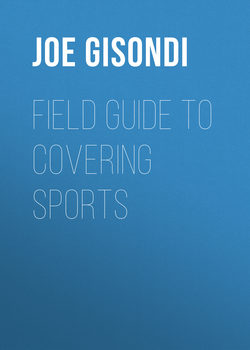Читать книгу Field Guide to Covering Sports - Joe Gisondi - Страница 44
На сайте Литреса книга снята с продажи.
Ask
ОглавлениеYou’ll also need to talk to a wide range of people, everyone from friends to foes to teammates to opposing players and family members. One- or two-source feature stories are usually not worth printing. A hulking defensive lineman says he’s a lady’s man? Ask his mom. A volleyball libero says she can always spot where players are about to spike the ball? Ask opposing players and coaches to verify this. A coach says she’s haunted by a childhood event? Call her friends and family to get more details. Ultimately, you may not even quote some of these people, but their insights will enable you to find the proper perspective or some compelling angles. If you have time to speak with someone else, do so. Struggling with information? Call a source again. Your job is to collect information and to gain perspective, which means speaking to as many people as possible. So get back on the phone, go to the gym, or head to a local hangout and keep talking. Good writers often say they don’t stop reporting until they’ve heard the same thing three times.
▸ The Washington Post’s Dave Sheinin says he creates one-page outlines that he glances over during slower moments in interviews to remind himself of key points he wants to address. “I don’t like to stare at my notes and recite questions as if I’m reading off a teleprompter,” he says. “I like to keep eye contact during interviews.”
▸ Ask numerous follow-up questions in order to get enough information to write authoritatively about people, places, things, or issues. Don’t go on to the next topic until you have enough questions to fully understand an issue or to develop a detailed scene.
▸ The person profiled may be the last person you speak with. Gather stories first from others who are less guarded in offering information and insights. Friends and family are usually more than willing to gab about one another.
▸ Be candid with potential sources, letting them know what you want to learn, whom you’ve already spoken with, and what you already know. This approach can help build your credibility and also reveal that others are talking. “There’s a phrase I heard once: ‘The more you know, the more you’ll get,’” says Dave Hyde. “The more you know about a story and can tell the person you’re interviewing, the more that person is going to tell you. He or she will see you have some information and so won’t be so hesitant to talk.”
▸ Don’t hesitate to call sources several times for a single story. You might even want to end an interview by saying something like this: “Would you mind if I call back if I have more questions or need to clarify something?” Few people will decline this invitation to verify and clarify details.
▸ Don’t be afraid to ask questions, even about something as sensitive as losing a friend or being embarrassed about dyslexia. Readers seek stories that reveal these intimate and emotional aspects of athletes and coaches. In the piece on a Packers rookie running back, Dume kept asking questions, respectfully but persistently: “All I did was keep asking for examples and how he coped with the disorder mentally,” Dunne said. “How we did deal with each setback? How did he grow as a person with each setback? Sometimes it might be weird to ask somebody for minute details on what it’s like living in a car or what it’s like to read in front of a classroom but when it’s on paper, it flows organically. Details. Details. Get those and the story comes alive.”
▸ Keep talking until you find a major conflict. Once this person starts talking, listen for visual markers and other specific details that will enable you to paint the story more clearly. If this information is not supplied, ask for it: “What was the weather like?” “Where were you standing?” “Describe the trail you ran on.” “What did the heat feel like?” There are a million ways to write a profile or feature, but there is really one primary factor that drives these stories—conflict. So go find it. Your readers will be most thankful.
